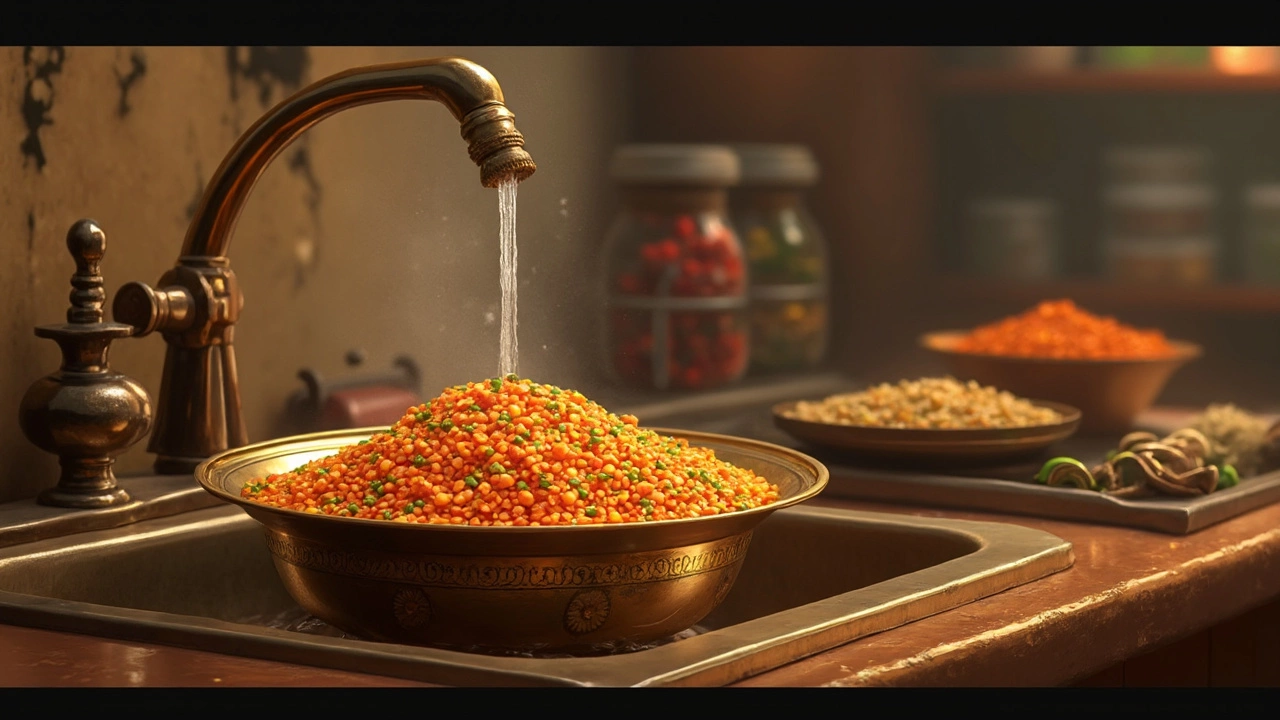Ever wondered why some people insist on rinsing lentils before cooking? It seems like an extra step, but it really makes a difference. First off, rinsing gets rid of dust, dirt, and tiny stones—you don’t want crunchy surprises in your dal, do you? Even if they look clean, those pesky particles can sneak in during packaging.
Besides the dirt factor, rinsing helps wash away compounds called oligosaccharides. These carbs are notorious for causing bloating and gas—a definite mood killer at the dinner table. Less gas means more enjoyment of your delicious, spicy dal. And, it enhances the final texture, giving you that perfect, creamy consistency every time.
- The Importance of Rinsing Lentils
- What You Risk by Skipping the Rinse
- How to Properly Rinse Lentils
- Benefits of Rinsed Lentils in Dal Recipes
The Importance of Rinsing Lentils
Before you dive into cooking your favorite dal recipe, making sure to rinse your lentils is more crucial than you might think. Not only does it ensure cleanliness, but it also improves the overall quality of your dish.
Cleanliness and Safety
Lentils can gather dust, dirt, and even tiny stones during harvesting, packaging, and transport. Rinsing them properly removes these contaminants. No one likes a gritty texture or unexpected crunch in their dal, right?
Reducing Gas and Bloating
Another big reason to rinse is to remove certain carbs called oligosaccharides. These troublemakers are known for causing gas and bloating. Give your digestive system a break and rinse those lentils to wash these away before you even start cooking.
Improving Taste and Texture
Rinsed lentils cook better, plain and simple. They absorb water evenly and cook to a consistent texture. This is especially vital for dal, where texture can make or break your dish. You end up with a creamy, smooth dal that is a joy to eat.
So, there you have it—rinsing lentils isn't just busywork. It directly improves quality, makes meals more enjoyable, and enhances flavors. Taking an extra minute for this step really pays off in the end.
What You Risk by Skipping the Rinse
Skipping the rinse step when cooking with lentils might seem like a time-saver, but it can bring more problems than you’d expect. One of the biggest risks involves finding unwanted particles in your meal. Lentils often carry tiny stones or bits of dirt from the harvesting and packaging processes. Nobody likes biting into grit while enjoying their dal, trust me.
There's also the issue of taste and texture. When you don't rinse lentils, residues from processing remain on them, which can add a muddy or even slightly bitter taste to your dish. The rinse is a quick fix that enhances the natural nuttiness of lentils, essential for a perfect dal recipe.
Digestive Discomfort
Another key reason to rinse is to avoid digestive discomfort. Lentils are high in a type of carbohydrate known as oligosaccharides. These guys are great for energy, but our stomachs can struggle to break them down properly, often leading to gas and bloating. By rinsing, you reduce these compounds, making your meal easier on the belly.
So, before you toss those lentils into your pot, give them a wash. It helps in cleansing impurities and lends to better-tasting dishes. Consider it your first step to an amazing dal.

How to Properly Rinse Lentils
If you've decided not to skip the rinse, you're on your way to a cleaner and tastier meal. So, how exactly should you go about rinsing those sneaky little legumes? It's easier than you think.
Step-by-step Guide
- Measure out your lentils according to your recipe. This way, you know exactly how much you'll be rinsing.
- Pour the lentils into a fine-mesh sieve or colander. A regular one might let them slip through, and nobody wants that hassle!
- Place the sieve under cold running water. Swirl the lentils around with your hands or a spoon to ensure they all get a rinse.
- Keep rinsing until the water runs clear. This might take a couple of minutes, as the water initially might be cloudy.
Now that they're rinsed, you're good to go! This simple task helps you to enjoy cleaner lentil recipes without unwanted surprises in texture or taste.
| Type of Lentil | Rinsing Time |
|---|---|
| Whole Green Lentils | About 2 minutes |
| Split Red Lentils | About 1 minute |
| Brown Lentils | About 2 minutes |
Remember, the key is consistency. Just make it a habit every time you cook dal or lentils, and soon you won't even think about it—just a quick swoosh under the tap and you're set!
Benefits of Rinsed Lentils in Dal Recipes
Alright, let's dive into why rinsing those lentils can seriously up your dal recipe game. If you've ever had a bowl of dal that just seemed off, it might’ve been those unrinsed lentils.
Better Flavor and Texture
Rinsing lentils removes any soil or debris, which can give your dal an unpleasant taste. Clean lentils ensure the flavors of your spices and other ingredients shine through without any earthy interruptions. Plus, washed lentils tend to cook more evenly, delivering that perfect creamy texture we all love.
Improved Digestibility
As mentioned earlier, rinsing lentils helps reduce the oligosaccharides. These are the type of carbs you're better off without, as they can contribute to those pesky digestive issues. A simple rinse can lead to a more comfortable post-meal feeling, saving you from that belly bloat.
A Healthier Dish
When you wash your lentils, you're also washing away any potential pesticides or chemicals used during cultivation. This is a pretty big deal if you’re mindful about what goes into your food. Even if your lentils are labeled organic, they might still have residues from the processing or packaging stages.
Making Rinsing Quick and Easy
Here’s a quick rundown on how to rinse lentils effectively:
- Place the lentils in a sieve or strainer.
- Run cold water over them, stirring occasionally.
- Keep rinsing until the water runs clear, which should take a minute or so.
And that’s it! This little step can make a huge difference in your culinary creations and keep your lentil experiences positive.
